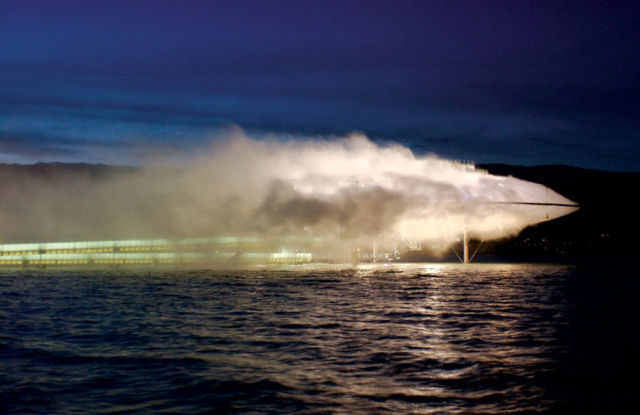4.
gigantes 14 year s ago
it sounds cool to me, and i understand why the swiss made it:
The Blur Building was built for the Swiss Expo 2002 on Lake Neuchatel. It is an architecture of atmosphere. The lightweight tensegrity structure measures 300 feet wide by 200 feet deep by 75 feet high. The primary building material is indigenous to the site, water. Water is pumped from the lake, filtered, and shot as a fine mist through 31,500 high-pressure mist nozzles. A smart weather system reads the shifting climactic conditions of temperature, humidity, wind speed and direction, and processes the data in a central computer that regulates water pressure.
Upon entering the fog mass, visual and acoustic references are erased, leaving only an optical "white-out" and the "white-noise" of pulsing nozzles. Blur is an anti-spectacle. Contrary to immersive environments that strive for high-definition visual fidelity with ever-greater technical virtuosity, Blur is decidedly low-definition: there is nothing to see but our dependence on vision itself.
{from the site "dillerscofidio"}
Upon entering the fog mass, visual and acoustic references are erased, leaving only an optical "white-out" and the "white-noise" of pulsing nozzles. Blur is an anti-spectacle. Contrary to immersive environments that strive for high-definition visual fidelity with ever-greater technical virtuosity, Blur is decidedly low-definition: there is nothing to see but our dependence on vision itself.
{from the site "dillerscofidio"}



Upon entering the fog mass, visual and acoustic references are erased, leaving only an optical "white-out" and the "white-noise" of pulsing nozzles. Blur is an anti-spectacle. Contrary to immersive environments that strive for high-definition visual fidelity with ever-greater technical virtuosity, Blur is decidedly low-definition: there is nothing to see but our dependence on vision itself.
{from the site "dillerscofidio"}